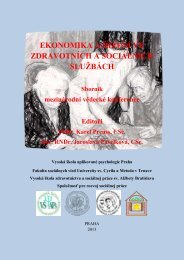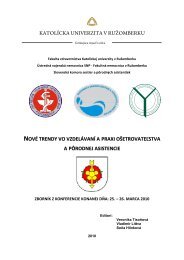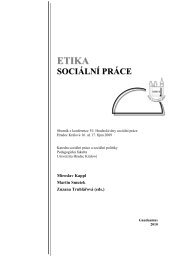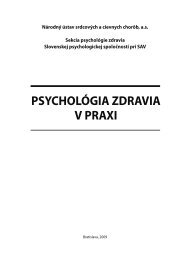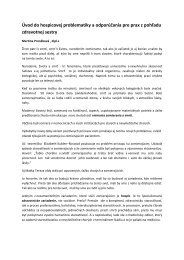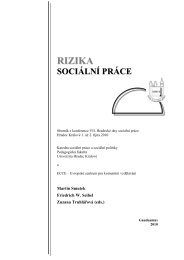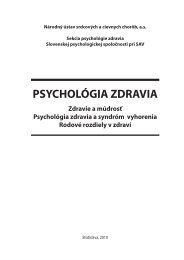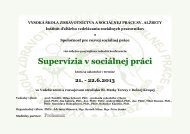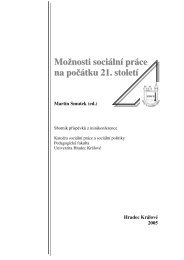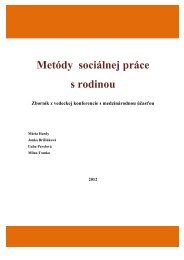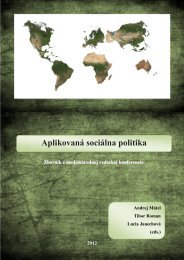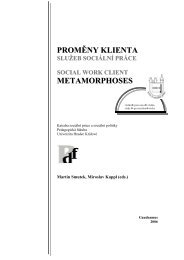Zmena klÃmy â možný dopad (nielen) na obyvateľstvo - Prohuman
Zmena klÃmy â možný dopad (nielen) na obyvateľstvo - Prohuman
Zmena klÃmy â možný dopad (nielen) na obyvateľstvo - Prohuman
You also want an ePaper? Increase the reach of your titles
YUMPU automatically turns print PDFs into web optimized ePapers that Google loves.
the global North and the global South, along with the global North’s domi<strong>na</strong>nce<br />
in shaping systems (economic, belief, cultural and others). It encourages the<br />
learner, rather than empathising with others, to “recognise oneself as implicated<br />
in the social forces that create the climate of obstacles the other must confront”<br />
(Boler, 1997, p. 257). It prioritises of open-ended self-reflection over more didactic<br />
messages, thereby establishing moral obligations to act (Andreotti, 2006, p. 48).<br />
Evident within these different approaches to global citizenship education are two<br />
conceptions of justice/injustice within a development education context – one<br />
which focuses on the unequal distribution of goods per se, and the other which<br />
emphasises the causes of that unequal distribution. Education approaches which<br />
appeal to the learners’ humanitarian principles and present poverty as a “lack” to<br />
which we are morally obliged to respond, explore justice from the perspective of<br />
global inequality. The world is unjust because of the stark unequal distribution of<br />
resources and opportunity; it is unjust because some have while others have not.<br />
The critical approach to global citizenship education emphasises the “chains of<br />
cause and effect” between the wealthy’s wealth and the poor’s poverty, the powerful’s<br />
power and the powerless’ powerlessness. It encourages a responsibility to<br />
act based on culpability.<br />
Young Children<br />
Educating for global justice involves complex and emotive issues which present<br />
challenges in an early childhood education context. Firstly, one might question<br />
the appropriateness of exposing young children to such political and sensitive<br />
issues. Secondly, if it is appropriate, making issues of global justice accessible to<br />
young children remains a challenge (Husband, 2010).<br />
The literature related to young children’s engagement with issues of global justice<br />
reveals conflicting attitudes regarding children’s perceived “readiness” to deal<br />
with global justice questions (Robinson and Jones Diaz, 2009; Kelly and Brooks,<br />
2009). Traditio<strong>na</strong>l perspectives construct children as being too young and too<br />
innocent to engage with “adult” issues. However, new ways of thinking about and<br />
understanding childhood and children’s learning have emerged from socio-cultural<br />
theory, postmodern/poststructuralist theories and from critical psychology<br />
(Robinson and Jones Diaz, 2009; Devine, 2003; Hong, 2003). Proponents of these<br />
new perspectives challenge conventio<strong>na</strong>l fixed definitions of childhood such as<br />
Piaget’s (1932) theory of cognitive-development,1 the perception of children as<br />
passive recipients of the domi<strong>na</strong>nt culture and many of the traditio<strong>na</strong>l universalised<br />
“truths” about “the child” which underpin modernist perspectives (Robinson<br />
and Jones Diaz, 2009; Devine, 2003). Moreover, postmodernist/poststructuralist<br />
166




